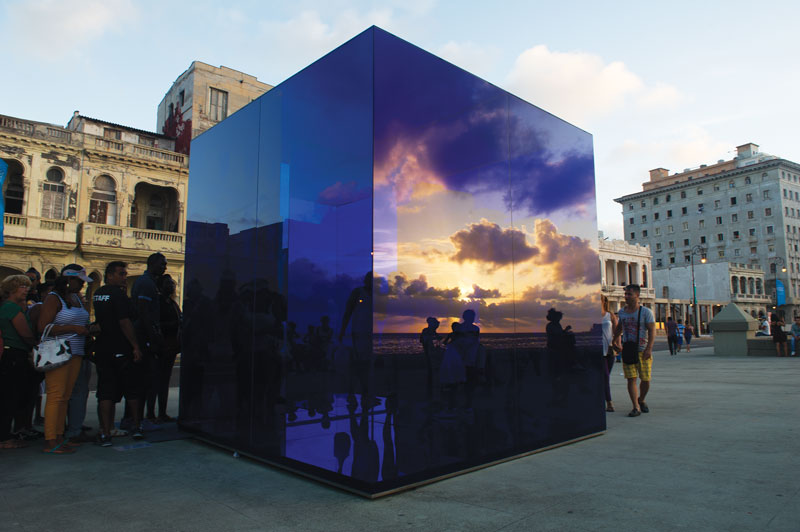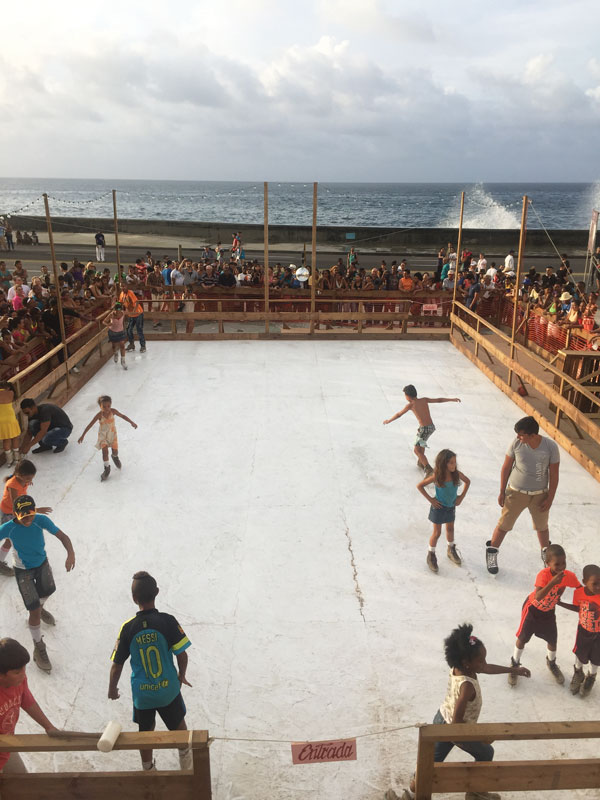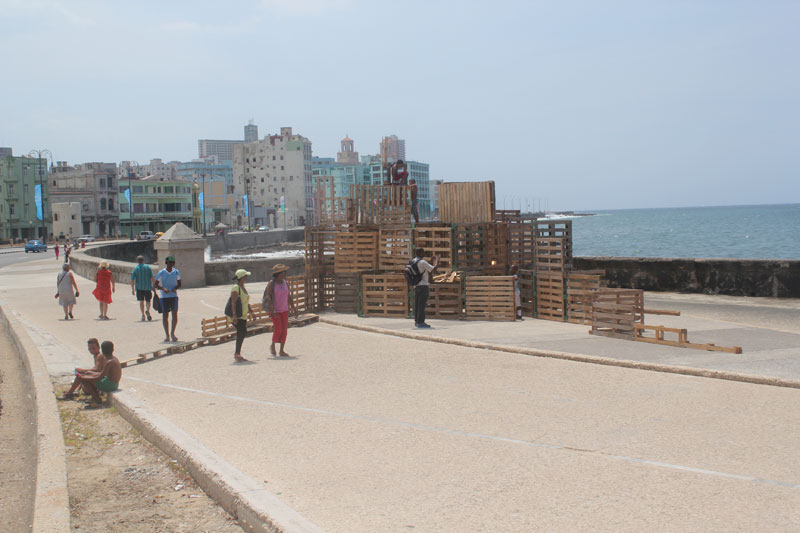« Reviews
Behind the Wall. 12th Havana Biennial
Curated by Juan Delgado Calzadilla
By Noel Smith
“Detrás del Muro (Behind the Wall),” the installation of public art works on the Havana Malecón, was one of the most appealing and accomplished projects of the recent 12th Havana Biennial. Curatorially, the variety and quality of works and the poetics of their placement on the storied seawall was effective, and it achieved one of the major objectives of recent biennials: accessibility. The 12th biennial reached far into remote and often impoverished areas of Havana, bringing art to people where they live; the Malecón is where Havana meets: it’s what curator Juan Delgado Calzadilla calls the “gran sofá.”
“Detrás del Muro” is the creation of Delgado, who from his home perch on the crumbling line of mansions facing the sea, has long observed the ever changing complexion of the water and various activities of the people who gather there daily and nightly to lean against the balustrade and find a refuge and relief from the crowded hot city in the ocean breeze. Delgado, director of Cuban Art Projects, began to see the possibilities of the Malecón as an urban museum, a place for the universalization of art. “Detrás del Muro” represents a massive effort by the workaholic Delgado, project advisor Elvia Rosa Castro, and a host of supporters and funders, artists, gallerists, and helpers all of whom devoted extraordinary resources in a country where materials are still so scarce that foreign artists exhibiting there must expect to bring in anything they will need, including hammers and nails.

Rachel Valdés Camejo, Cubo Azul (Blue Cube), 2015, mixed media installation, stainless steel and laminated glass, 118” x 118” x 118.” Courtesy of the artist.
The variety of works presented by the group of some fifty Cuban and international artists1 is striking, a collection including sculptures, visual art and musical performances, murals and billboards, smaller works and large-scale interactive spaces encouraging reflection and recreation. On the more or less mile and a half of Malecón, the works are sited according to a canny rhythm, as the prominent larger works draw the viewer on a path to also discover the more subtler creations tucked into corners or mounted on façades facing the sea.
Two showstopper installations more or less bookended the trajectory and highlighted elements of the history of the Malecón and the city. Cuban artist Arlés del Río conjured a typical beach scene, complete with sand, palm trees, and lounge chairs enthusiastically occupied by passersby. It was good fun, but the work’s title, Resaca, can be translated as “hangover” but also as “undercurrent,” and “reaction,” and its installation near the remains of abandoned public baths carved into the rocks of the shoreline, hinted at the consequences of the dearth of such recreational opportunities for today’s citizens of Havana.

Duke Riley, La Esquina Fría del Malecón, 2015. “Detrás del Muro” project, Havana Biennial. Cuban kids skate on 'ice' for the first time. A handful of old-timers remember past attempts to introduce ice skating into Cuba. Photo: Victor J. Webster.
On the other end of the Malecón, the US artist Duke Riley built La Esquina Fría Hielo (The Ice Corner) with a plastic surface that mimics ice, and brought in 200 pairs of skates to lend to the children thronging the rink at all times and who did particularly well with the unfamiliar bladed skates. The artist’s typical historical research uncovered the surprising presence of an ice hockey team, Los Trópicos, in pre-revolutionary Havana; the aesthetics of the installation recalled small town mid-century America with its wooden architecture and hand painted signs, not out of place in contemporary Havana with its fleets of vintage automobiles.
Riley was not alone among artists referencing an ongoing diplomatic “thaw” between Cuba and the United States, and the Malecón is an historically significant locale in which to do it. The first stretch of the seawall, from La Punta to Crespo Street, was actually built between 1901 and 1902 during the 1st American military occupation, and the US embassy, or Interests Section, has been located there since 1953.
Cuban artist Kadir López, whose multi-media works often employ material vestiges of the American presence in pre-revolutionary Cuba, contributed an uncharacteristic sculpture, Opuestos (Opposites). This airy, absurdist steel work, formed by two bows facing each other attempting to send the same arrow, the whole pointed north-south, is perfectly positioned in an apron at a natural bend and is nearly in sight of the US Interests Section located further down the road.
Moroccan artist Mounir Fatmi, who lives and works in Paris, created Obstáculos (Obstacles), from poles used to make jumps for equestrian competitions; painted in the red, white and blue of the American flag, they resembled a pile of pick up sticks, oriented north, blocking the path to the United States across the Florida Strait.

Arlés del Río, Resaca, 2015, tiki huts, palm trees, beach chairs, sand, variable dimensions. Courtesy of the artist.
Rachel Valdés (Cuba) invited a more phenomenological experience with Proyecto Reality: Cubo Azul. Entering the minimalistic cube formed by transparent blue panels, viewers stood on a mirrored floor and observed sky, clouds and sea merged and reflected off one another, creating a visually and sensorially distorted panorama of the Malecón.
Fidel álvarez (Colombia) also considered the environs in a work from the series Verbo insular; he brought a telescopic viewer trained on the horizon, with a text inscribed therein: “Discovering the horizon is seeing beyond the blue.” The access to this piece, like some other interactive sculptures, was limited, as the mechanism was removed when there was no one to attend it.
Performances included Aimée García’s (Cuba) handsome bearded model slowly removing a bright red military styled gown; the striptease drew curiosity and applause on the opening evening, but for display during the month long event, La dama de rojo (The Lady in Red) consisted of an empty vitrine with the dress lying crumpled on the ground, accompanied by a life sized photo of the model. Tapping into current fashion’s fascination with androgyny, the piece also drew attention to Cuba’s growing LGBT community.
In Destino Final (Final Destination) a performance blending savvy public relations and the growing practice of collecting data on consumers, álvaro José Brunet (Cuba) gave away his original, signed photographs to viewers in exchange for registering their official identity cards.
History and nostalgia distinguish the works of several Cuban American artists. José Rosabal, born in 1930 in Oriente, was a member of the pioneering group Diez Pintores Concretos, who were important proponents of abstraction on the island in the late 1950s. Rosabal’s three vertically oriented panels composing Fuente de Luz (Fountain of Light) fit neatly onto the ongoing patterns of the buildings around them.
Emilio Pérez, born in New York in 1972 of Cuban exile parents, contributed Un Verso Sencillo (A Simple Verse), inspired by the poetry of José Martí. The 64-foot long mural features background sea greens and blues and the rhythmic movement of large masses painted in faded pastels echoed the surrounding buildings and the cadences of Martí’s verses.
Like Rosabal, Glexis Novoa impacted the Cuban art scene before leaving for the United States in 1995. His site, a ruin that was once a hotel at the prominent corner of Paseo del Prado and the Malecón, was occupied by long time squatters, who along with others in the neighborhood, helped Novoa to clear the space of detritus and clean it up; they also stood guard on the site and welcomed visitors. Novoa prepared walls and columns with plaster and gesso, and using a jeweler’s loupe, made drawings no larger than 2 x 8 inches at eye level. The precise graphic images depict fantastic futuristic cities that might be Havana or Moscow, that blend symbols of bygone and current power-Tatlin’s tower, a toppled Lenin, a foreboding Kim Jong Un-and offer social and political critique. Here on the opening night, violinist Alejandro Junco played Shostakovich, creating an irresistible ambiance of romanticism, while visitors milling through the site discovered the drawings. The eye was drawn to the play between the intimate drawings, and the unlimited horizon beyond, linking the immediacy of the moment to the grand sweep of history that is Novoa’s subject.
Well-known and established Cuban artists contributing works were Manuel Mendive and Roberto Fabelo. Mendive’s Mi energía y yo (My Energy and Myself), a slight bronze figure accompanied by the representation of a spirit, was poised on the south side of the Malecón, as if to cross the street.
Fabelo’s Delicatessen, a large steel and aluminum cooking pot, was a black hole that absorbed everything around it and gave up nothing to the forks attempting to pierce its surface.

Othón Castañeda, Tzompantli, (City's skull rack), 2015, site-specific installation, standard pallets and construction lights, 12' x 80' x 80' feet. Courtesy of the artist.
Inti Hernández (Cuba) continued the theme of the pleasures and pitfalls of collectivization with traditional rocking chairs grouped cozily together, in Balance Cubano. Their often-witty entanglements provided ample opportunities for group confabs, but prevented any one individual from rocking in peace and solitude, as is the Cuban domestic habit and entitlement.
“Detrás del Muro” was on display for a month during the run of the 12th biennial. The street was closed to traffic on Sundays, which greatly facilitated the enjoyment of the inaugural event on May 24. A soft breeze wafted in from the calm Caribbean Sea, the sky was clear and the temperature reasonable. Thousands of Cubans and tourists strolled along the Malecón, looking and interacting with the art, listening to the jazz band, hearing the venerable lady singing praises to goddess of the sea Yemayá, enjoying the perfect evening. “Detrás del Muro” was a fabulous party on the gran sofá, with art the honored guest.
(May 24-June 22, 2015)
Notes
1. “Detrás del Muro” participating artists included the Cubans Adonis Ferro, Adonis Flores, Aimée García, Alexander Guerra, Alvaro José Brunet, Ariel Orozco, Arles del Río, Carlos Montes de Oca, David Beltrán, Dayán Díaz Curbelo, Duvier del Dago, Ernesto García Sánchez, Ernesto Javier Fernández, Florencio Gelabert, Glexis Novoa, Inti Hernández, Jacqueline Maggi, José Rosabal, Juan Milanés, Kadir López, Jorge Enrique Valdéz, Ludmila López, Manuel A. Hernández Cardona, Manuel Mendive, Nereida García Ferraz, Pablo Rosendo, Rachel Valdés, Rafael M. San Juan, Rafael Villares, Reynier Leyva Novo, Ricardo Rodríguez, Roberto Fabelo, Victor Piverno and Stainless (Alejandro Piñeiro, José Gabriel Capaz and Roberto Fabelo Hung). They exhibited along with Andreas Feist (Germany), Carlos Nicanor (Cuba-Canary Islands), David Opdyke (USA), Duke Riley (Ireland-USA), Emilio Pérez (USA), Ewerdt Hilgemann (Germany), Fidel Alvarez (Colombia), Humberto Vélez (Panama), José Parlá (USA), Lina Leal (Colombia), Mounir Fatmi (Morocco), Othón Castañeda (Mexico), Oweena Fogarty (Mexico-Ireland), Pilar Rubí (Bolivia-Spain), Tijuana-based Proyecto NOEMA (Lance A. Olsen, Luis Ituarte, Chris Warren and Roberto Romero-Molina), Raquel Paiewonsky (Dominican Republic), and Saafa Erruas (Morocco).
Noel Smith is curator of Latin American and Caribbean art and curator of education for the Institute for Research in Art: Contemporary Art Museum and Graphicstudio (IRA) at the University of South Florida in Tampa. She also directs the USF Museum Studies Graduate Certificate program.
Filed Under: Reviews



































Leave a Reply
You must be logged in to post a comment.